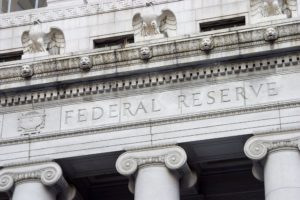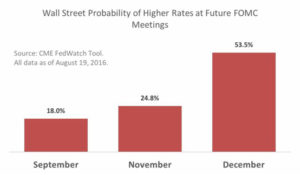
The S&P 500 and Dow ended last week slightly lower, but the NASDAQ posted an eighth straight week of gains for the first time since 2010.[1] For the week, the S&P 500 lost 0.01%, the Dow fell 0.13%, the NASDAQ gained 0.10%,and the MSCI EAFE lost 0.64%.[2]
What is the Fed thinking? Minutes from the July Federal Reserve Open Market Committee meeting showed that officials are split about the economic outlook and when to raise interest rates. Hawkish rhetoric from Fed members who favor a rate hike soon could push the central bank into raising rates as early as September. More dovish officials aren’t convinced that tepid inflation will rise to the Fed’s 2.0% objective and favor a wait-and-see approach to raising interest rates.[3]
After several months of strong labor market gains, some economists think the economy is close to full employment and central bankers should move soon to put on the brakes by raising interest rates. If the economy gets overheated, prices could rise too much and push the economy into a boom/bust cycle that federal officials are anxious to avoid.
While a few years of outsized growth might sound nice after the years of slow expansion we’ve experienced, the economic hangover that might follow wouldn’t be pleasant at all. That’s why central banks like the Fed act to smooth out these economic cycles by lowering interest rates when times are tough (boosting investment through cheap credit) and raising them when growth picks up again (curbing excessive optimism by making credit more expensive).
The timing of rate increases is tricky, and the macroeconomic relationships that govern these decisions are complex and open to interpretation. Hence why some of the best economists in the world can’t agree on when to pull the trigger.
Which group will win out at the Fed? Since the Fed has been reluctant to jump the gun on interest rates, we don’t see a rate hike coming next month. However, the Fed might decide to surprise us.
Currently, Wall Street traders judge the odds of a September hike at just 18.0%. However, traders think the Fed is likely to raise interest rates in 2016, judging by December’s rate probabilities.[4] Will the Fed move soon? We’ll keep you informed.
 This week is packed with economic data that will show us how the housing and manufacturing sectors are doing. We’ll also get a second look at second-quarter economic growth in Friday’s Gross Domestic Product report. Stay tuned for next week’s update.
This week is packed with economic data that will show us how the housing and manufacturing sectors are doing. We’ll also get a second look at second-quarter economic growth in Friday’s Gross Domestic Product report. Stay tuned for next week’s update.
ECONOMIC CALENDAR:
Tuesday: New Home Sales
Wednesday: PMI Manufacturing Index Flash, Existing Home Sales, EIA Petroleum Status Report
Thursday: Durable Goods Orders, Jobless Claims
Friday: GDP, International Trade in Goods, Corporate Profits, PMI Services Flash, Consumer Sentiment
 Notes: All index returns exclude reinvested dividends, and the 5-year and 10-year returns are annualized. Sources: Yahoo! Finance, S&P Dow Jones Indices, and Treasury.gov. International performance is represented by the MSCI EAFE Index. Corporate bond performance is represented by the SPUSCIG. Past performance is no guarantee of future results. Indices are unmanaged and cannot be invested into directly.
Notes: All index returns exclude reinvested dividends, and the 5-year and 10-year returns are annualized. Sources: Yahoo! Finance, S&P Dow Jones Indices, and Treasury.gov. International performance is represented by the MSCI EAFE Index. Corporate bond performance is represented by the SPUSCIG. Past performance is no guarantee of future results. Indices are unmanaged and cannot be invested into directly.
Inflation remains flat. Consumer prices remained unchanged in July as gasoline prices fell for the first time in months. Modest inflation may reduce the chances of future interest rate increases by the Federal Reserve.[5]
Housing starts surge to five-month high. Groundbreaking on new residential projects rose in July, potentially boosting second-quarter economic growth numbers.[6]
Weekly jobless claims fall. The number of Americans filing new claims for unemployment benefits dropped last week, suggesting the labor market continues to strengthen and approach full employment.[7]
Industrial production rises more than expected. A measure of industrial sector production (including hard industries like mining, manufacturing, and utilities) increased by 0.7% versus the 0.3% rise expected.[8]
Sources: